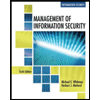
a.
Achieving Alignment:
Difficulty of business-MIS alignment:
Due to the communication gap between the officials who handles business and IT, it is very difficult to align business with IT. In addition, IT environment is changing rapidly which makes difficult for business to incorporate all changes easily.
a.
Explanation of Solution
Prioritize the demands:
Companies can prioritize the demands of various business units in the following ways:
- To reduce risk in business operations, different strategies are made by the information technology executives. The risk can be a consequence of poor planning and execution of projects.
- In order to make the entire process easy and smooth, IT companies make use of
operational systems like project and resource management. Balance between IT and business objectives make it possible for the companies to prioritize investments and lay emphasize on “the right set of things.” - In order to reduce their entire IT expenses on infrastructure, IT executives can adopt asset rationalization measures. This requires identification of the right opportunities for data centre, and then creating optimal plans.
b.
Achieving Alignment:
Difficulty of business-MIS alignment:
Due to the communication gap between the officials who handles business and IT, it is very difficult to align business with IT. In addition, IT environment is changing rapidly which makes difficult for business to incorporate all changes easily.
b.
Explanation of Solution
MIS Challenges
Some of the greatest MIS challenges for the coming year may include:
Security - Security issue is one of the most important issues in terms of MIS challenges. Various security issues include crime, Data Encryption Standards, Biometric Devices, Disaster Planning, Hacking etc.
c.
Achieving Alignment:
Difficulty of business-MIS alignment:
Due to the communication gap between the officials who handles business and IT, it is very difficult to align business with IT. In addition, IT environment is changing rapidly which makes difficult for business to incorporate all changes easily.
Driving MIS decisions:
Following issues drive MIS decisions:
- Investments in MIS tend to improve productivity of the company.
- MIS investments are associated with company's business goals and objectives.
d.
Achieving Alignment:
Difficulty of business-MIS alignment:
Due to the communication gap between the officials who handles business and IT, it is very difficult to align business with IT. In addition, IT environment is changing rapidly which makes difficult for business to incorporate all changes easily.
Moving Force behind MIS Decisions:
Generally, the chief information officer (CIO) and the MIS department are responsible for making MIS decisions. Companies must also examine technology decision continuously to ensure its proper implementation.
e.
Achieving Alignment:
Difficulty of business-MIS alignment:
Due to the communication gap between the officials who handles business and IT, it is very difficult to align business with IT. In addition, IT environment is changing rapidly which makes difficult for business to incorporate all changes easily.
Efficiency Metrics and Effectiveness Metrics:
Efficiency and Effectiveness Metrics used by Companies to Measure the Impact of MIS are as mentioned below:
- Performance
- Speed
- Throughput
- Web metrics
- Scalability
- Net Present Value (NPV)
- Return on Investment (ROI)
- Total Cost of Ownership (TCO)
f.
Achieving Alignment:
Difficulty of business-MIS alignment:
Due to the communication gap between the officials who handles business and IT, it is very difficult to align business with IT. In addition, IT environment is changing rapidly which makes difficult for business to incorporate all changes easily.
Using Financial Metrics:
Financial metrics can be used to monitor and measure MIS investments in following ways:
- Net present value (NPV) - NPV metric makes a comparison between the investment cost and present value of unexpected future cash flows generated by the project.
- Internal Rate of Return (IRR) - It identifies the rate at which the net present value of an investment is zero.
- Return on Investment (ROI) - It indicates the earning capacity of a project.
- Payback Period (PB – It is essentially the time required for a project to pay for itself.
- Total Cost of Ownership (TCO) - It consists of the costs- direct and indirect- incurred during the asset’s life cycle. It attempts to state the MIS investment costs.
g.
Achieving Alignment:
Difficulty of business-MIS alignment:
Due to the communication gap between the officials who handles business and IT, it is very difficult to align business with IT. In addition, IT environment is changing rapidly which makes difficult for business to incorporate all changes easily.
Issues with using financial metrics:
Use of financial metrics to evaluate MIS will not lead to successful results. It is difficult to apply a financial metric on a computer or firewall. Thus, it is quite a difficult job to measure MIS value with financial metrics.
c.
Achieving Alignment:
Difficulty of business-MIS alignment:
Due to the communication gap between the officials who handles business and IT, it is very difficult to align business with IT. In addition, IT environment is changing rapidly which makes difficult for business to incorporate all changes easily.
c.
Explanation of Solution
Driving MIS decisions:
Following issues drive MIS decisions:
- Investments in MIS tend to improve productivity of the company.
- MIS investments are associated with company's business goals and objectives.
d.
Achieving Alignment:
Difficulty of business-MIS alignment:
Due to the communication gap between the officials who handles business and IT, it is very difficult to align business with IT. In addition, IT environment is changing rapidly which makes difficult for business to incorporate all changes easily.
d.
Explanation of Solution
Moving Force behind MIS Decisions:
Generally, the chief information officer (CIO) and the MIS department are responsible for making MIS decisions. Companies must also examine technology decision continuously to ensure its proper implementation.
e.
Achieving Alignment:
Difficulty of business-MIS alignment:
Due to the communication gap between the officials who handles business and IT, it is very difficult to align business with IT. In addition, IT environment is changing rapidly which makes difficult for business to incorporate all changes easily.
e.
Explanation of Solution
Efficiency Metrics and Effectiveness Metrics:
Efficiency and Effectiveness Metrics used by Companies to Measure the Impact of MIS are as mentioned below:
- Performance
- Speed
- Throughput
- Web metrics
- Scalability
- Net Present Value (NPV)
- Return on Investment (ROI)
- Total Cost of Ownership (TCO)
f.
Achieving Alignment:
Difficulty of business-MIS alignment:
Due to the communication gap between the officials who handles business and IT, it is very difficult to align business with IT. In addition, IT environment is changing rapidly which makes difficult for business to incorporate all changes easily.
f.
Explanation of Solution
Using Financial Metrics:
Financial metrics can be used to monitor and measure MIS investments in following ways:
- Net present value (NPV) - NPV metric makes a comparison between the investment cost and present value of unexpected future cash flows generated by the project.
- Internal Rate of Return (IRR) - It identifies the rate at which the net present value of an investment is zero.
- Return on Investment (ROI) - It indicates the earning capacity of a project.
- Payback Period (PB – It is essentially the time required for a project to pay for itself.
- Total Cost of Ownership (TCO) - It consists of the costs- direct and indirect- incurred during the asset’s life cycle. It attempts to state the MIS investment costs.
g.
Achieving Alignment:
Difficulty of business-MIS alignment:
Due to the communication gap between the officials who handles business and IT, it is very difficult to align business with IT. In addition, IT environment is changing rapidly which makes difficult for business to incorporate all changes easily.
g.
Explanation of Solution
Issues with using financial metrics:
Use of financial metrics to evaluate MIS will not lead to successful results. It is difficult to apply a financial metric on a computer or firewall. Thus, it is quite a difficult job to measure MIS value with financial metrics.
Want to see more full solutions like this?
Chapter 5 Solutions
BUSINESS DRIVEN TECHNOLOGY(LL)-W/ACCESS
- "Do not use AI tools. Solve the problem by hand on paper only and upload a photo of your handwritten solution."arrow_forwardSolve this "Do not use AI tools. Solve the problem by hand on paper only and upload a photo of your handwritten solution."arrow_forwardSolve this "Do not use AI tools. Solve the problem by hand on paper only and upload a photo of your handwritten solution."arrow_forward
- Specifications: Part-2Part-2: DescriptionIn this part of the lab, we will illuminate two 7-segment displays. You will need to understand 2's Complement todetermine when the input 4-bit binary number corresponds to a negative or positive number. To understand how anLED display works in Digital, please refer to the playWithLED_Display.dig file provided. You should play withdifferent input combinations to see how it influences the LED Display value. In the screenshot below, note how I wasable to generate the display of “3” on the Hex display by lighting up only certain input wires to the unit. Here is a picture of how the different segments light up to produce the different displays: Note in the picture above that we showed displays only from 0-8 since in 4-bit 2s complement representation, 8 is thelargest modulus value you can represent (the range of integers would be -8 to +7).Your circuit in Part-2 must accept a 4-bit 2's complement input {in3, in2, in1, in0} where in3 is the most…arrow_forwardSolve this "Do not use AI tools. Solve the problem by hand on paper only and upload a photo of your handwritten solution."arrow_forwardSolve this "Do not use AI tools. Solve the problem by hand on paper only and upload a photo of your handwritten solution."arrow_forward
- Solve this "Do not use AI tools. Solve the problem by hand on paper only and upload a photo of your handwritten solution."arrow_forwardSolve this "Do not use AI tools. Solve the problem by hand on paper only and upload a photo of your handwritten solution."arrow_forwardSolve this "Do not use AI tools. Solve the problem by hand on paper only and upload a photo of your handwritten solution."arrow_forward
- Solve this "Do not use AI tools. Solve the problem by hand on paper only and upload a photo of your handwritten solution."arrow_forwardSolve this "Do not use AI tools. Solve the problem by hand on paper only and upload a photo of your handwritten solution."arrow_forwardSolve this "Do not use AI tools. Solve the problem by hand on paper only and upload a photo of your handwritten solution."arrow_forward
 Fundamentals of Information SystemsComputer ScienceISBN:9781305082168Author:Ralph Stair, George ReynoldsPublisher:Cengage Learning
Fundamentals of Information SystemsComputer ScienceISBN:9781305082168Author:Ralph Stair, George ReynoldsPublisher:Cengage Learning Principles of Information Systems (MindTap Course...Computer ScienceISBN:9781305971776Author:Ralph Stair, George ReynoldsPublisher:Cengage Learning
Principles of Information Systems (MindTap Course...Computer ScienceISBN:9781305971776Author:Ralph Stair, George ReynoldsPublisher:Cengage Learning Principles of Information Systems (MindTap Course...Computer ScienceISBN:9781285867168Author:Ralph Stair, George ReynoldsPublisher:Cengage Learning
Principles of Information Systems (MindTap Course...Computer ScienceISBN:9781285867168Author:Ralph Stair, George ReynoldsPublisher:Cengage Learning Fundamentals of Information SystemsComputer ScienceISBN:9781337097536Author:Ralph Stair, George ReynoldsPublisher:Cengage Learning
Fundamentals of Information SystemsComputer ScienceISBN:9781337097536Author:Ralph Stair, George ReynoldsPublisher:Cengage Learning Management Of Information SecurityComputer ScienceISBN:9781337405713Author:WHITMAN, Michael.Publisher:Cengage Learning,
Management Of Information SecurityComputer ScienceISBN:9781337405713Author:WHITMAN, Michael.Publisher:Cengage Learning, Information Technology Project ManagementComputer ScienceISBN:9781337101356Author:Kathy SchwalbePublisher:Cengage Learning
Information Technology Project ManagementComputer ScienceISBN:9781337101356Author:Kathy SchwalbePublisher:Cengage Learning





